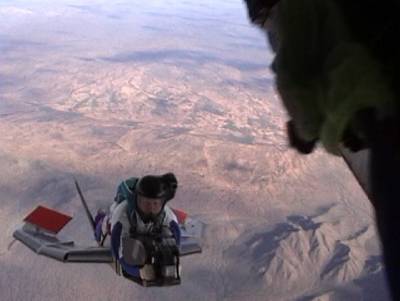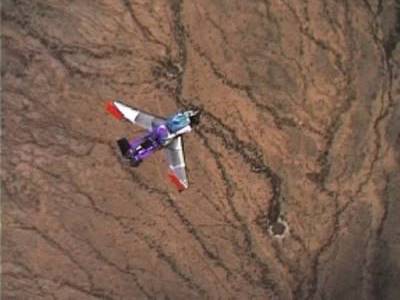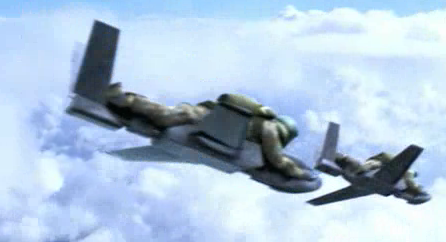

For full resolution/full size pictures above: click here.
Jpegs captured from in-flight video documentation
2001.



For full resolution/full size pictures above: click here.
Jpegs captured from in-flight video documentation
2001.

|
Kinetic Aerospace Inc. E-mail: queries@kineticaerospace.com or phone 541-895-2038
Or "Switchblade" as it's called in the 20th James Bond film,
Yes, those are PHASST gliders carting superspies James Bond and Jinx Johnson (played by Pierce Brosnan and Halle Berry, respectively) into the face of peril. They're the reason Kinetic Aerospace Inc. pulled the PHASST test flight photos off the company's www.kineticaerospace.com web site for a year.
Amazingly (amazing at least to KA's lead designer, Jack McCornack), the producers of the film wanted the Switchblades to look like the version Kinetic Aerospace flew at Eloy, AZ in January 2001. "I thought their art department would go crazy with [the Switchblades]," said McCornack, "but they wanted them identical to our first flight test model, right down to the paint job."
According to Kinetic Aerospace's president, Dave Rogers, this put the company in a bit of a quandary. "We were honor- and contract-bound to keep the Switchblade image and information under wraps," said Rogers. "Since Switchblades look and fly just like PHASSTs, we felt the most discreet thing to do was to block public access to kineticaerospace.com until the film was released." Rogers acknowledged the company's other projects are not publicly accessible at present, saying, "If we couldn't keep secrets, we couldn't keep customers."
McCornack claims he was pleased to see how director Lee Tamahori handled the Switchblade scene. "It's brief, but realistic," said McCornack, "The good guys get in unobserved, thanks to a fast cruise, good glide performance, and minimal radar signature. It's a wonderful promotion for the PHASST."
Glimpses of Switchblade flight grace the official Die Another Day trailer, and all five of MGM's television ads for the film. Flash and QuickTime movies are available on
www.jamesbond.com and www.mgm.com
For more information regarding Switchblades, email bond20project@kineticaerospace.com
Kinetic Aerospace Inc. builds specialized aircraft and provides equipment and services for these aircraft, such as launch mechanisms and on-location/field support. If you have a specific question about our aircraft, or would like us to quote on a project of your own, please contact us at queries@kineticaerospace.com or phone 541-895-2038
Kinetic Aerospace Inc.
|
|
PHASST Makes First Flights
ELOY, AZ: Early in 2001, a new breed of aircraft took wing two miles above the Arizona
desert. The PHASST (Programmable High Altitude Single Soldier Transport), pronounced
"fast" flew
three test missions in January, launched from a Skyvan jump plane and landing in desert
rangeland near the Picacho Mountains, east of Eloy. All three launches were
at 12,000 feet, with development pilot Allan Hewitt separating from the
PHASST at 6000 feet and landing under his own canopy.
The PHASST is designed to carry a paratrooper or skydiver, and as such is
designed around parachuting skills rather than airplane pilot skills. The
PHASST pilot flies in a "tracking" position (prone, head forward), the
aircraft is dynamically stable in all three axes, and like a parachute, has
no elevator, rudder, or aileron input. Instead, the pilot has brakes on each
wingtip, which control direction and drag, much like the brakes on a ram-air
parachute.
Hewitt was chosen for his considerable parachuting experience, which includes
a stint with the British Army's Red Devils display team, and also his powered
parachute experience, which includes stunt piloting a Parahawk in the 19th
James Bond film, The World is Not Enough. He met PHASST designer Jack
McCornack while both were working on that film, on location in the French Alps.
"We needed someone who would be a quick study, since we couldn't draw from a
pool of pilots who had flown this sort of thing," said McCornack. "There is
no 'this sort of thing.'"
Described as "more something you wear than something you ride," the PHASST
is contoured to fit the pilot, with the pilot's arms and legs fitting into
recesses in the fuselage. Sweep is variable in flight, with a minimum
wingspan of 5-1/2 feet for deployment from the transport plane and rapid
decent, and a maximum wingspan of 8 feet for cruise and slow flight.
The PHASST is launched tail-first with wings folded, from the rear ramp of
the transport plane. Once free of the plane, the PHASST pilot spreads the
wings and begins a high speed glide to his destination. On arrival, he
releases the PHASST and tracks away, then opens his parachute and lands in
the normal skydiving manner. The PHASST can then land under its own canopy,
or fly unmanned under remote guidance or programmed instructions.
According to McCornack, the first flight tests were meant to "...practice the
launches, make sure the pilot can get clear [of the PHASST] easily in flight,
and prove the practicality of the concept. And though we intend the PHASST to
literally fly itself, Allan needs some time on it before we can explore its
performance envelope."
Current PHASST test projects include autopilot control and autonomous navigation by GPS, which allows the PHASST to follow a preprogrammed course without pilot input. The
pilot will be able to overpower the navigation system through use of the
wingtip brakes, should the situation warrant such action.
Hewitt reported the PHASST was "a rock steady jump platform" for his two low
speed (100 mph) separations, but "a bit of a handful" in his one high speed
(197 mph recorded) separation. Hewitt recommended future PHASST pilots "...put
on the brakes before bailing out."
Three chase jumpers videoed the tests, and found the task challenging. "When
Allan circled, we dropped right past him," said Andy Bennett, rigger and
jumpmaster for the flights. "and when he put the nose down and tracked, he
shot off toward the horizon much faster than we could go."
The tests were a joint effort by Kinetic Aerospace Inc., which
built the PHASST, and Sky Science Inc., which provided the pilot, rigger,
recovery system, and cameramen. According to Kinetic Aerospace marketing VP Dave
Rogers, the next manned tests will involve two PHASSTs, so "...the cameraman
will have a way to keep up." He said future development plans include a
turbojet powered version, which is expected to cruise at 180 knots and have a
100 mile range.
Rogers explained the six month delay between the January 2001 test flights
and the release of information as "...a courtesy to a customer, but now that
we've met those needs, we're ready to brag."
The company is seeking clients in the military, film, and recreational
markets, for both the glider and turbojet versions.
For more information contact Dave Rogers at drogers@kineticaerospace.com or
850-668-6363, or write Kinetic Aerospace Inc., PO Box 50103, Eugene, OR 97405.
Captions:
PHASST CRUISE With wings spread to full span, the PHASST "flat tracks" below
a video cameraman.
--end--
|